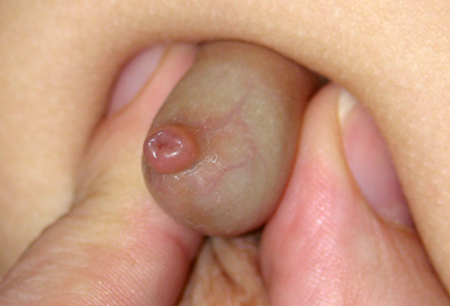Congenital (physiological) phimosis occurs in 96% of newborns, with the tip of the glans visible in only 50% of newborn boys.[5]Gairdner D. The fate of the foreskin. A study of circumcision. Br Med J. 1949 Dec 24;2(4642):1433-7.
http://www.ncbi.nlm.nih.gov/pmc/articles/PMC2051968/pdf/brmedj03656-0009.pdf
http://www.ncbi.nlm.nih.gov/pubmed/15408299?tool=bestpractice.com
[6]Morris BJ, Matthews JG, Krieger JN. Prevalence of phimosis in males of all ages: systematic review. Urology. 2020 Jan;135:124-32.
http://www.ncbi.nlm.nih.gov/pubmed/31655079?tool=bestpractice.com
[Figure caption and citation for the preceding image starts]: Physiological phimosisFrom the collection of Nicol Corbin Bush, MD [Citation ends]. The foreskin becomes retractable at varying ages. In a prospective evaluation of more than 1000 boys over 8 years of follow-up in Denmark, congenital phimosis was present in 8% of 6- to 7-year-olds.[7]Øster J. Further fate of the foreskin. Incidence of preputial adhesions, phimosis, and smegma among Danish schoolboys. Arch Dis Child. 1968 Apr;43(228):200-3.
http://www.ncbi.nlm.nih.gov/pmc/articles/PMC2019851/pdf/archdisch01557-0066.pdf
http://www.ncbi.nlm.nih.gov/pubmed/5689532?tool=bestpractice.com
Prevalence in this group declined to 1% of 16- to 17-year-old boys.[7]Øster J. Further fate of the foreskin. Incidence of preputial adhesions, phimosis, and smegma among Danish schoolboys. Arch Dis Child. 1968 Apr;43(228):200-3.
http://www.ncbi.nlm.nih.gov/pmc/articles/PMC2019851/pdf/archdisch01557-0066.pdf
http://www.ncbi.nlm.nih.gov/pubmed/5689532?tool=bestpractice.com
The foreskin becomes retractable at varying ages. In a prospective evaluation of more than 1000 boys over 8 years of follow-up in Denmark, congenital phimosis was present in 8% of 6- to 7-year-olds.[7]Øster J. Further fate of the foreskin. Incidence of preputial adhesions, phimosis, and smegma among Danish schoolboys. Arch Dis Child. 1968 Apr;43(228):200-3.
http://www.ncbi.nlm.nih.gov/pmc/articles/PMC2019851/pdf/archdisch01557-0066.pdf
http://www.ncbi.nlm.nih.gov/pubmed/5689532?tool=bestpractice.com
Prevalence in this group declined to 1% of 16- to 17-year-old boys.[7]Øster J. Further fate of the foreskin. Incidence of preputial adhesions, phimosis, and smegma among Danish schoolboys. Arch Dis Child. 1968 Apr;43(228):200-3.
http://www.ncbi.nlm.nih.gov/pmc/articles/PMC2019851/pdf/archdisch01557-0066.pdf
http://www.ncbi.nlm.nih.gov/pubmed/5689532?tool=bestpractice.com
The reported prevalence of acquired (pathological) phimosis varies widely. A rate of 1% of uncircumcised males is commonly reported.[8]Spilsbury K, Semmens JB, Wisniewski ZS, et al. Circumcision for phimosis and other medical indications in Western Australian boys. Med J Aust. 2003 Feb 17;178(4):155-8.
http://www.ncbi.nlm.nih.gov/pubmed/12580740?tool=bestpractice.com
[9]Shankar KR, Rickwood AM. The incidence of phimosis in boys. BJU Int. 1999 Jul;84(1):101-2.
http://www.ncbi.nlm.nih.gov/pubmed/10444134?tool=bestpractice.com
Acquired phimosis is more common in men with a history of diabetes.[6]Morris BJ, Matthews JG, Krieger JN. Prevalence of phimosis in males of all ages: systematic review. Urology. 2020 Jan;135:124-32.
http://www.ncbi.nlm.nih.gov/pubmed/31655079?tool=bestpractice.com
[10]Bromage SJ, Crump A, Pearce I. Phimosis as a presenting feature of diabetes. BJU Int. 2008 Feb;101(3):338-40.
http://www.ncbi.nlm.nih.gov/pubmed/18005214?tool=bestpractice.com
The prevalence of phimosis in men of all ages is widely variable; many studies appear to include both physiological and pathological phimosis in their cohorts.[6]Morris BJ, Matthews JG, Krieger JN. Prevalence of phimosis in males of all ages: systematic review. Urology. 2020 Jan;135:124-32.
http://www.ncbi.nlm.nih.gov/pubmed/31655079?tool=bestpractice.com
Paraphimosis is seen exclusively in uncircumcised or partially circumcised males. Its true incidence is unknown.
The estimated prevalence of congenital penile curvature at birth varies from 0.6% to 20%.[11]European Association of Urology; European Society for Paediatric Urology. EAU guidelines on paediatric urology. Apr 2024 [internet publication].
https://uroweb.org/guidelines/paediatric-urology
[12]Bhat A, Bhat M, Kumar V, et al. The incidence of isolated penile torsion in North India: a study of 5,018 male neonates. J Pediatr Urol. 2017 Oct;13(5):491.e1-491.e6.
http://www.ncbi.nlm.nih.gov/pubmed/28344020?tool=bestpractice.com
[13]Eroglu E, Gundogdu G. Isolated penile torsion in newborns. Can Urol Assoc J. 2015 Nov 4;9(11-12):E805-7.
https://www.ncbi.nlm.nih.gov/pmc/articles/PMC4639432
http://www.ncbi.nlm.nih.gov/pubmed/26600889?tool=bestpractice.com
Congenital penile curvature >30 degrees is considered clinically significant.[11]European Association of Urology; European Society for Paediatric Urology. EAU guidelines on paediatric urology. Apr 2024 [internet publication].
https://uroweb.org/guidelines/paediatric-urology
Congenital buried penis (megaprepuce) is uncommon; its true incidence is unknown.
Hypospadias prevalence estimates vary widely. International birth defect surveillance systems suggest hypospadias prevalence of 21 per 10,000 births during the period 1980 to 2010.[14]Yu X, Nassar N, Mastroiacovo P, et al. Hypospadias prevalence and trends in international birth defect surveillance systems, 1980-2010. Eur Urol. 2019 Oct;76(4):482-90.
https://www.ncbi.nlm.nih.gov/pmc/articles/PMC7265200
http://www.ncbi.nlm.nih.gov/pubmed/31300237?tool=bestpractice.com
In North America, prevalence of 34 to 83 per 10,000 live births has been reported.[15]Springer A, van den Heijkant M, Baumann S. Worldwide prevalence of hypospadias. J Pediatr Urol. 2016 Jun;12(3):152.e1-7.
http://www.ncbi.nlm.nih.gov/pubmed/26810252?tool=bestpractice.com
[16]Shan X, Aguilar S, Canon S. Hypospadias prevalence by severity and associated risk factors: a population-based active surveillance analysis. J Pediatr Urol. 2023 Dec;19(6):720.e1-720.e9.
http://www.ncbi.nlm.nih.gov/pubmed/37640620?tool=bestpractice.com
[17]Chen MJ, Karaviti LP, Roth DR, et al. Birth prevalence of hypospadias and hypospadias risk factors in newborn males in the United States from 1997 to 2012. J Pediatr Urol. 2018 Oct;14(5):425.e1-425.e7.
http://www.ncbi.nlm.nih.gov/pubmed/30322769?tool=bestpractice.com
Analysis of the Paris Registry of Congenital Malformations indicates that, between 1981 and 2020, hypospadias comprised 18% of reported non-genetic anomalies.[18]Monier I, Hachem S, Goffinet F, et al. Population-based surveillance of congenital anomalies over 40 years (1981-2020): results from the Paris registry of congenital malformations (remaPAR). J Gynecol Obstet Hum Reprod. 2024 Jun;53(6):102780.
http://www.ncbi.nlm.nih.gov/pubmed/38552958?tool=bestpractice.com
Most patients have distal hypospadias.
 The foreskin becomes retractable at varying ages. In a prospective evaluation of more than 1000 boys over 8 years of follow-up in Denmark, congenital phimosis was present in 8% of 6- to 7-year-olds.[7] Prevalence in this group declined to 1% of 16- to 17-year-old boys.[7]
The foreskin becomes retractable at varying ages. In a prospective evaluation of more than 1000 boys over 8 years of follow-up in Denmark, congenital phimosis was present in 8% of 6- to 7-year-olds.[7] Prevalence in this group declined to 1% of 16- to 17-year-old boys.[7]